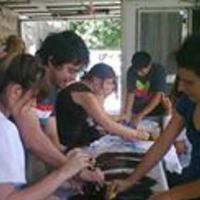Papers by Alfonso Bustos S.
El capítulo con el que se cierra este libro, que posiblemente el lector ya ha revisado en su

Http Dx Doi Org 10 1080 02103702 2015 1016745, Mar 31, 2015
The information provided to participants regarding their activity is a key focus of recent studie... more The information provided to participants regarding their activity is a key focus of recent studies aiming to improve the processes and outcomes of computer-supported collaborative learning. The information that is ultimately made available is linked to that considered to be important for online collaborative learning processes. The study presented here attaches special importance both to educational influence and to the distribution of this influence among the participants. Participants were 42 university students. They were given information regarding certain indicators of their participation in the forums, which were theoretically related to the exercise of educational influence at both group and individual levels. The objectives were to analyse the impact of information on the evolution of activity across the forums, and the relationship with the value that participants assigned to the forums and the usefulness of the forums in the learning process. The results indicated that only individual information had a significant impact on participation in subsequent forums. Future studies should incorporate questions related to the meaning that participants ascribe to the information provided to them. La información proporcionada a los participantes sobre su actividad es un foco habitual de los estudios recientes orientados a mejorar los procesos y los resultados del aprendizaje colaborativo apoyado por ordenador. Los aspectos específicos sobre los que se les proporciona información dependen de cómo se entienden los procesos de aprendizaje colaborativo. Este trabajo concede especial importancia tanto a la influencia educativa como a la distribución de esta influencia entre los participantes. Los participantes fueron 42 estudiantes universitarios a los que se proporcionó información, grupal e individual, sobre indicadores teóricamente relacionados con su ejercicio de la influencia educativa en una serie de foros. Los objetivos del estudio fueron analizar el impacto de la información proporcionada a los participantes sobre la evolución de su actividad y la valoración de su utilidad en el proceso de aprendizaje en los sucesivos foros. Los resultados indicaron que sólo la información individual tuvo un efecto significativo sobre la participación en foros posteriores. Estudios futuros deberán analizar el sentido que los participantes atribuyen a la información proporcionada.
"Comentario para la presentación del libro Portafolios electrónicos: diseño tecn... more "Comentario para la presentación del libro Portafolios electrónicos: diseño tecnopedagógico y experiencias educativas Editores: Dra. Frida Díaz Barriga Arceo, Dr. Marco Antonio Rigo Lemini y Dr. Gerardo Hernández Rojas. Ciudad Universitaria, México, D.F. 10 de septiembre de 2013 "
Introducción (Invitado 2) 2.1. Diseño de la estructura del programa y la propuesta para la WWW (w... more Introducción (Invitado 2) 2.1. Diseño de la estructura del programa y la propuesta para la WWW (world wide web) 2.1.1. Modelo para el diseño de una comunidad virtual de aprendizaje de software básico 2.1.2. Diseño de los componentes del laboratorio en línea 2.1.3. Balance final de la aplicación del laboratorio en línea Conclusiones Anexo I Anexo 2 Referencias Tecnologías de Interconexión aplicadas a la EDUCACIÓN SUPERIOR

El capítulo con el que se cierra este libro, que posiblemente el lector ya ha revisado en su conj... more El capítulo con el que se cierra este libro, que posiblemente el lector ya ha revisado en su conjunto, surge con el propósito de mirar hacia el futuro en lo que se ha llamado la escuela de las pantallas. Las miradas de futuro son siempre un riesgo y requieren algunos referentes que ofrezcan, más que una perspectiva futurista, una oportunidad para la reflexión de ciertos aspectos centrales respecto de la temática sobre la que se intenta ofrecer una mirada prospectiva. En este sentido, desde el punto de vista del interés sobre las potencialidades y limitaciones de las tecnologías de la información y la comunicación (TIC) para transformar la educación o lo que podríamos identificar, tal como Artopoulos y Lion nos proponen en el capítulo introductorio, como el abordaje de la última frontera de la expansión digital (la educación), a lo largo de este capítulo desarrollaremos tres ideas básicas. En primer lugar, proponemos un trayecto de ida y vuelta entre el pasado, el presente y el futur...
Aula de Innovación Educativa, 2009
Biblioteca de la Universidad Complutense de Madrid, Base de datos de artículos de revistas, ...

This work explores some methodological challenges in the application of Social Network Analysis (... more This work explores some methodological challenges in the application of Social Network Analysis (SNA) to the study of Asynchronous Learning Networks (ALN). Our interest in the SNA is situated within the framework of the study of Distributed Teaching Presence (DTP), understood as the exercise of educational influence, through a multi-method approach that integrates structural analysis of the activity and content analysis of the participants' contributions. Within the first of these analyses, our aim is twofold: to present a set of indices of the participants' communicative patterns oriented toward the study of DTP, and to discuss the most appropriate data source for calculating such indices. The indices are illustrated through the analysis of a didactic sequence (DS) based on two data sources: the activity logs (log files) and personal references or allusions to others that can be found in each participant's contributions. Our results show that the proposed set of indi...

Entrepreneur, 2021
Desde distintos ámbitos se venía planteando, incluso mucho antes del 2020, que comenzábamos el tr... more Desde distintos ámbitos se venía planteando, incluso mucho antes del 2020, que comenzábamos el tránsito hacia sistemas económicos y estructuras sociales que darían forma a la revolución digital o la cuarta transformación industrial (Schwab, 2016). Se argumentaba ya que dicha revolución estaría marcada por la convergencia de tecnologías digitales, físicas y biológicas que cambiarían el mundo tal como lo conocemos, sobre todo el mundo del trabajo. Así, se esperaba un impacto profundo en los modelos de negocio, las estructuras de las organizaciones y su cultura, la empleabilidad, el mercado laboral e incluso la cualificación profesional. Después de los casi diez meses de confinamiento por la pandemia del Covid-19, y habiendo cerrado recientemente el año 2020, se sugiere que en todo el mundo se ha acelerado la digitalización, es decir, la revolución digital. Como sociedad nos hemos visto obligados a teletrabajar de manera intensiva; a estudiar en modelos totalmente digitales, hibridos o a distancia; incluso las empresas en todos los sectores se han visto obligadas a cambiar/redefinir sus modelos de negocio. La reconversión obligada de múltiples negocios de todos los sectores supone repensar las estrategias para crear valor, rediseñar la gestión de los procesos internos digitalizados, reorganizar la oferta y distribución de los productos así como participar en nuevos ecosistemas de socios y proveedores. Sabemos que todo ello es fundamental, no obstante, conviene señalar que el aspecto vital para lograr dicha reconversión tiene que ver con las personas, sus capacidades y la forma en la que se adapten a ese futuro del trabajo. De hecho, un estudio de Roca-Salvatella (RocaSalvatella-ESADE, 2020) a propósito del impacto del Covid-19 en la transformación digital concluye, entre otras cosas, que uno de los frenos a dicha transformación sigue siendo la falta de formación de los líderes empresariales respecto de las competencias digitales. Todavía más, los autores de este informe insisten en que el foco de la transformación, siempre teniendo en cuenta los aspectos contextuales de cada organización, ya no estará en la adquisición de nueva tecnología sino en el desarrollo e incorporación de nuevas capacidades. ¿Qué capacidades y para qué futuro? Comencemos por un conjunto de datos que se publicaron a finales del año pasado en el Future of Job Report 2020 del World Economic Forum (WEF, 2020) desde donde se hace una prospectiva hacia 2025 respecto del tipo de trabajo y las habilidades que se requerirán. En primer lugar, indica este informe, se espera que el 40% de las habilidades "core" de los trabajadores cambien en los siguientes 5 años; y que el 50% de todos los empleados

Inclusao Social, 2019
The process of transformation or profound change
in the economic systems and social structures of... more The process of transformation or profound change
in the economic systems and social structures of a
society is usually characterized as a revolution. In
these terms, since the beginning of the 21st century,
the transformation process of our current society has
been described from di#erent areas.
On the one hand, from sociology, Zygmunt
Bauman warns that we are in a stage of liquid
times, liquid relationships, liquid organizations
and even liquid work, that is, in the stage of liquid
modernity (BAUMAN, 2003). On the other hand,
from a context of business strategy, the notion of an
environment characterized by volatility, uncertainty,
complexity and ambiguity (VUCA) has been used. It
is in this VUCA context in which both organizations
and people live their current and future situation,
and from where certain processes of planning and
development policies are addressed (WOLF, 2007).
Portal coordinado por el área educativa de Red.es y el Ministerio de Industria, Turismo y Comerci... more Portal coordinado por el área educativa de Red.es y el Ministerio de Industria, Turismo y Comercio, con el objetivo de impulsar el uso de las TIC en la educación de acuerdo con las líneas estratégicas del Plan Avanza y en el marco del programa ~Internet en el Aula~. Ofrece noticias, recursos educativos digitales listos para su utilización en el aula, páginas web de referencia y herramientas de autor.
El trabajo presenta un modelo para el diseño de una comunidad virtual de aprendizaje (CVA) en el ... more El trabajo presenta un modelo para el diseño de una comunidad virtual de aprendizaje (CVA) en el marco de un programa de postgrado, concretamente del Master y del Doc-torado Interuniversitario de Psicología de la Educación (MIPE/DIPE). En este modelo, ...











Uploads
Papers by Alfonso Bustos S.
in the economic systems and social structures of a
society is usually characterized as a revolution. In
these terms, since the beginning of the 21st century,
the transformation process of our current society has
been described from di#erent areas.
On the one hand, from sociology, Zygmunt
Bauman warns that we are in a stage of liquid
times, liquid relationships, liquid organizations
and even liquid work, that is, in the stage of liquid
modernity (BAUMAN, 2003). On the other hand,
from a context of business strategy, the notion of an
environment characterized by volatility, uncertainty,
complexity and ambiguity (VUCA) has been used. It
is in this VUCA context in which both organizations
and people live their current and future situation,
and from where certain processes of planning and
development policies are addressed (WOLF, 2007).
in the economic systems and social structures of a
society is usually characterized as a revolution. In
these terms, since the beginning of the 21st century,
the transformation process of our current society has
been described from di#erent areas.
On the one hand, from sociology, Zygmunt
Bauman warns that we are in a stage of liquid
times, liquid relationships, liquid organizations
and even liquid work, that is, in the stage of liquid
modernity (BAUMAN, 2003). On the other hand,
from a context of business strategy, the notion of an
environment characterized by volatility, uncertainty,
complexity and ambiguity (VUCA) has been used. It
is in this VUCA context in which both organizations
and people live their current and future situation,
and from where certain processes of planning and
development policies are addressed (WOLF, 2007).
En primer lugar, proponemos un trayecto de ida y vuelta entre el pasado, el presente y el futuro con el propósito de realizar un ejercicio prospectivo, siempre partiendo de algunas evidencias sobre lo que ya hemos hecho en el ámbito de las prácticas educativas mediadas por las TIC digitales, lo que hacemos actualmente y lo que podemos adivinar que estaremos haciendo. Para ello, partiremos de un viejo debate sobre las potencialidades de las TIC en educación y recorreremos algunas ideas centrales de cada uno de los capítulos de este libro que nos servirán como evidencia del presente, del pasado y del futuro.
En segundo lugar, nos proponemos echar un vistazo al horizonte de lo que en un futuro a corto, mediano o largo plazo condicionará de alguna manera las formas en las que las TIC podrían incorporarse en las prácticas educativas. Para ello, seguiremos un conjunto de informes sobre la emergencia de determinadas tecnologías y su impacto en el ámbito de la educación escolar y seleccionaremos un conjunto de ellas que nos parecen de interés también desde la relectura de los casos presentados en este libro. Igualmente, haremos referencia a un conjunto de miradas diversas sobre el futuro de la educación transformada gracias a los usos de las TIC que van desde las perspectivas “futuristas” tecnocéntricas, que poco compartimos pero que no carecen de interés, hasta las que apelan a la transformación de las prácticas socioculturales en función de los contextos, las regiones, etc.
En tercer y último lugar, nos referiremos a un conjunto de desafíos futuros para la educación escolar en el marco de la sociedad del siglo XXI y de los usos de las TIC digitales. Presentaremos la idea final de que las escuelas de las pantallas tendrán su reto más grande en un escenario futuro sin muros, de contextos interconectados en suma de ser un contexto más, pero igualmente muy relevante, en una nueva ecología del aprendizaje.
Débora Kozak (coordinadora)
Alejandro Artopoulos
Alfonso Bustos Sánchez
Virginia Funes
Carina Lion
• El impacto de las TIC sobre la educación y la psicología de la educación. Se centran en el estudio de los procesos de aprendizaje que tienen lugar como consecuencia de la participación de las personas en situaciones y actividades educativas caracterizadas por el uso de tecnologías digitales de la información y la comunicación.
• Factores y procesos psicológicos implicados en el aprendizaje virtual: Una mirada constructivista. Se tratan los tres vértices del triángulo interactivo: el aprendiz, el profesor y los contenidos del aprendizaje, así como sus interrelaciones.
• Entornos virtuales de enseñanza y aprendizaje. Se enfoca a los contextos instruccionales, de naturaleza virtual, que cuentan con una mayor presencia y aceptación en la actualidad, tanto entre los proyectos educativos más innovadores como en la investigación educativa y psicoeducativa.
• La enseñanza y el aprendizaje de competencias básicas en entornos virtuales. Se orienta a las principales competencias de carácter transversal consideradas en la mayoría de los informes internacionales como habilidades imprescindibles para sobrevivir en la sociedad-red.
Dichos dispositivos han impulsado el desarrollo de lo que podríamos identificar como una nueva “ecología del aprendizaje”. Me propongo compartir la idea de que en dicha ecología los nichos o contextos de aprendizaje (formal, informal, etc.) en los que participamos se transforman, interconectan y gestionan de manera cada vez más “personal” gracias a la “portabilidad” entre contextos que nos ofrecen, justamente, los dispositivos como las tabletas.
El aprendizaje es un proceso continuo que no se detiene cuando un estudiante sale del ámbito escolar formal. Las experiencias de aprendizaje continuarán, sobre todo con la aparición de alta el acceso a las tecnologías móviles y dispositivos que se utilizan para muchos propósitos educativos y comunicativos. Muchos investigadores han discutido cómo las actividades de aprendizaje fuera-el-aula como experimentos, descubrimientos accidentales, eventos y diversas experiencias se pueden clasificar como el aprendizaje informal (Falk & Dierking, 1998; Casco y Schultz, 2001; Khaddage y Knezek, 2013). Estos pueden influir en las experiencias generales de aprendizaje entre los estudiantes, por lo tanto, la creación de nuevas oportunidades de aprendizaje. Las tecnologías móviles y aplicaciones pueden desempeñar un papel importante en el entorno de aprendizaje informal, ya que pueden ser utilizados para la comunicación, la colaboración, la recopilación y el intercambio de información
Si usamos tabletas en las aulas como mecanismos para reducir barreras -escuelas y aulas porosas-, promoveremos que entren en las aulas conocimientos, relaciones, representaciones, instrumentos y “voces” que pueden transformar la forma en que ayudamos a aprender a los estudiantes. ¡Dejemos que nuestros estudiantes lleven consigo sus contextos de aprendizaje al aula, y viceversa del aula a los contextos informales, para conseguir que atribuyan sentido y significado a lo que aprenden!
#Ciencia_Abierta?
• ¿Qué es la #Ciencia_Abierta?
• ¿Cuáles son los principios de la #Ciencia_Abierta?
Editores: Dra. Frida Díaz Barriga Arceo, Dr. Marco Antonio Rigo Lemini y Dr. Gerardo Hernández Rojas.
Ciudad Universitaria, México, D.F. 10 de septiembre de 2013
The main objective of our proposal is related with the use of a PLE platform in order to promote innovation in the design of higher education environments. The design should offering more flexibility and possibilities to combine the institutional (formal) virtual environment with a more customizable environment that the students should configured following their interests and preferences. In this way, students could have more control over managing their own learning processes. Using PLE platform, our aim is to encourage students to explicit and share with other some resources, services and online applications even to share their own network learning whereby they participate in different educational and professional contexts.
In this proposal we describe the first phase of the Project. The main focus of this phase has been a pilot study in order to evaluate Elgg, an Open Source Social Networking Engine, as the technological platform to allow the students configuring their personal learning environments. We detail the overall design decisions regarding the selection and configuration of Elgg’s tools or widgets for building PLE. From our perspective, PLE building should consider three different levels of resources or widgets: widgets for elaborating information, widgets for sharing information and widgets for publicizing information. The different widgets, at the three levels, should offer the possibilities to work in three levels of "activity”: personal level, small group level and the whole community level. In short, from of our point of view, building a PLE suppose decide how to create, organize and maintain both the personal network of resources for learning as the persons from whom to learn at any moment.
Finally, we analyze the structure of the PLEs configured by a group of 16 students over a semester and the effective uses of the possibilities offered by the several tools. We contrast too these results with the assessment of the students themselves about their experience in configuring and using these environments for learning.
Keywords: Personal Learning Environment, Learning Ecologies, Higher Education, Elgg."
(C. Coll, A. Bustos & A. Engel. EuroCat-CSCeL Workshop, 5-6th February 2010)
In the context of this seminar, our paper reports a model oriented towards the analysis of distributed teaching presence (DTP) understood as the exercise of educational influence; that is to say, as the set of supports and helps offered by and between the participants in an ALN to promote individual and collective learning. More concretely, we will present a multi-method approach to the study of the distributed teaching presence in ALN that combines structural analysis of the participants' activity with content analysis of the participants' contributions (Coll, Engel & Bustos, 2009; Coll, Bustos & Engel, in press).
The concept of teaching presence has some similarities with the concepts of adjustment of educational supports and educational influence developed in the framework of a socio-cultural constructivist approach to teaching and learning processes (Coll, Onrubia & Mauri, 2008). From this perspective, students and teachers, and more generally participants in learning settings, get involved in joint activities through which they progressively construct systems of shared meanings about the content which is being addressed and the task they are carrying out (Mercer, 1995; 2000). The progress in the construction of the systems of shared meanings takes place thanks to the educational influence of others, that is to say, to the set of supports provided by the participants throughout the course of the joint activity. More concretely, according to this approach, the supports offered during the joint activity can be oriented to the “organization of the academic task” (Stodolsky, 1991; Grossman & Stodolsky, 1995), the “organization of the social participation” (Erickson, 1982) or even the meanings being addressed by learning activity.
With this perspective in mind, the nature and the intensity of the help that the students can receive from the teacher and their peers, as well as the possibilities of adjusting this help to the process of knowledge construction that they are carrying out, depend on their commitment and their involvement in the joint activity in at least two complementary levels: the participants’ activity in the digital context (structural analysis) and the relevance of their contributions in the process of shared meanings construction (content analysis).
On the one hand, from the perspective of the structural analysis, the participants must access to the digital environment from time to time, and they must revise –read– the others’ contributions, and make contributions –write– with certain frequency and continuity in order to be able to help and guide the rest of the participants effectively, as well as to make use of the help and direction that they might receive from others. Thus, participants who meet these criteria (reading, writing and continuity) may be identified as potential carriers of teaching presence since they are able to offer adjusted and useful support to other participants. At the same time, meeting the criteria of access, reading and writing, these participants, thanks to a reciprocity principle, can take advantage of support offered by the other.
In order to analyze and understand this aspect of joint activity, we propose to identify the participants' activity profiles. The main data source in this case is the log files offered by the electronic environment. The structural indicators chosen for this analysis have been selected according to their relevance for gaining information on the mutual processes of help, as well as on the possibilities of adjusting this help between the participants. Some of these indicators inform us on the participants' presence –in terms of access– in the platform –, their participation – written and read contributions– and the temporal continuity and distribution of this participation. Other indicators inform us on connectivity between the participants; that is to say, on with whom they interact and the established relations of reciprocity and responsiveness.
On the other hand, from the perspective of the content analysis, the participants’ contributions must be relevant for the process of shared meanings on content and learning tasks. This way, content analysis becomes another essential component of our approach to the study of distributed teaching presence. The contributions of participants can be related with one or more of the three essential dimensions involved in joint activity: the management of the social participation, the management of the academic task and the management of meanings. The participants whose contributions provide supports in one or more of these dimensions may be identified as real carriers of teaching presence.
In the framework of a multi-method approach to the study of distributed teaching presence in the ALN, while structural analysis informs us about the potential degree of exercise of teaching presence and on the potential degree of the distribution of the teaching presence among the participants, content analysis, following the map drawn by structural analysis, allows us to verify whether participants identified as potential carriers are in fact real carriers of teaching presence.
Introducing this approach and findings we have found in our research, we intend to discuss some issues identified by the organizers of the workshop. Thus, we will refer to the study of the temporal variable or, as the organizers propose, to the relevance of a longitudinal approach in the analysis of the CSCeL. In addition we will refer to the organizational aspects of the activity, in order to find some guides to answer questions as: how to study group or collective organisation in CSCeL settings? Is a certain level of organisation necessary for knowledge convergence? Are opportunities for knowledge convergence increasing when the organisation efforts are decreasing? Which factors affect organisation convergence? Finally, we will make some comments that, from our perspective, can be useful for thinking on the possibilities and constraints of the design of awareness tools.
References
Coll, C., Bustos, A. & Engel, A. (in press). Perfiles de participación y presencia docente distribuida en redes asíncronas de aprendizaje: la articulación del análisis estructural y de contenido. Revista de Educación, (accepted).
Coll, C., Engel, A. & Bustos, A. (2009). Distributed Teaching Presence and Participants' activity profiles: A theoretical approach to the structural analysis of Asynchronous Learning Networks. European Journal of Education, 44(4), 521-538.
Coll, C., Onrubia, J. & Mauri, T. (2008). Ayudar a aprender en contextos educativos: el ejercicio de la influencia educativa y el análisis de la enseñanza. Revista de Educación,
346, 33-70.
Grossman, P. & Stodolsky, S. S. (1995). Content as context: the role of school subjects in secondary school teaching. Educational Researcher, 24(8), 5-23.
Mercer, N. (1995). The guided construction of knowledge. Talk amongs teachers and learners. Clevedon: Multilingual Matters Ltd. [La construcción guiada del conocimiento. El habla de profesores y alumnos. Barcelona: Paidós, 1997].
Mercer. N. (2000). Words & Minds. London: Routledge [Palabras y mentes. Cómo usamos el lenguaje para pensar juntos. Barcelona: Paidós, 2001].
Stodolsky, S. S. (1988). The subject matters. Classroom activity in Math and Social Studies. Chicago: The University of Chicago Press [La importancia del contenido en la enseñanza. Actividades en las clases de Matemáticas y Ciencias Sociales. Barcelona: Paidós/MEC]
Debido al reconocimiento de otros contextos relevantes para aprender, la innovación podría venir de áreas muy diversas, e impulsar la relación dentro-fuera / fuera-dentro
La personalización, como uno de los retos más relevantes, exigirá mucho más que la innovación esté centrada en los aprendices involucrándolos desde las fases iniciales (ideación, diseño, iterando con ellos para promover la “innovación incremental”).